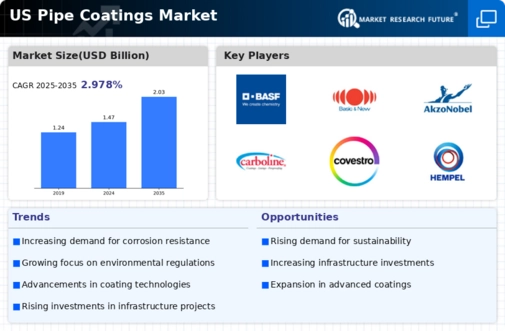The pipe coatings market exhibits a dynamic competitive landscape characterized by innovation and strategic partnerships. Key players such as AkzoNobel (NL), BASF (DE), and Sherwin-Williams (US) are actively shaping the market through their distinct operational focuses. AkzoNobel (NL) emphasizes sustainability in its product offerings, aligning with global environmental standards, while BASF (DE) leverages its extensive research capabilities to develop advanced coating technologies. Sherwin-Williams (US) appears to be concentrating on regional expansion, enhancing its market presence through targeted acquisitions and local manufacturing initiatives. Collectively, these strategies foster a competitive environment that prioritizes innovation and sustainability, driving growth in the sector.
In terms of business tactics, companies are increasingly localizing manufacturing to reduce lead times and optimize supply chains. This approach not only enhances operational efficiency but also allows for better responsiveness to regional market demands. The competitive structure of the market is moderately fragmented, with several players vying for market share. However, the influence of major companies remains substantial, as they set industry standards and drive technological advancements.
In October 2025, PPG Industries (US) announced a strategic partnership with a leading technology firm to integrate AI into its coating application processes. This move is likely to enhance efficiency and precision in coating applications, thereby reducing waste and improving overall product performance. The integration of AI signifies a shift towards more technologically advanced solutions in the market, potentially setting a new benchmark for operational excellence.
In September 2025, 3M (US) launched a new line of eco-friendly pipe coatings designed to meet stringent environmental regulations. This initiative not only reflects the growing demand for sustainable products but also positions 3M (US) as a leader in environmentally responsible manufacturing. The introduction of these coatings may attract environmentally conscious customers and strengthen the company's market position.
In August 2025, Hempel (DK) expanded its manufacturing capabilities in North America by investing in a new facility dedicated to producing high-performance coatings. This expansion is indicative of Hempel's commitment to meeting the increasing demand for advanced coatings in the region. By enhancing its production capacity, Hempel (DK) is likely to improve its competitive edge and respond more effectively to customer needs.
As of November 2025, the competitive trends in the pipe coatings market are increasingly defined by digitalization, sustainability, and technological integration. Strategic alliances are becoming more prevalent, enabling companies to pool resources and expertise to innovate more rapidly. The shift from price-based competition to a focus on innovation and supply chain reliability is evident, suggesting that future competitive differentiation will hinge on technological advancements and sustainable practices. Companies that can effectively leverage these trends are likely to secure a more favorable position in the evolving market landscape.



















Leave a Comment